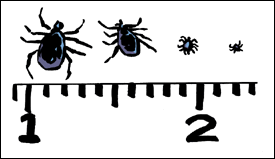TICK TACTICS

Heading for the trails? Make sure you don’t pick up any unwanted baggage along the way—like ticks. Be on the lookout for these pesky creatures that lurk in moist, shaded woods, low-growing brush, dense weeds, or piles of leaves. Ticks can also be found sneaking around your neighborhood—even in your own backyard especially in woodpiles and areas of high grass. One bite from these creepy little critters can cause diseases like Lyme disease or Rocky Mountain spotted fever.
So how do ticks get on you? Ticks don’t jump or fly—you can pick them up on your clothes, skin, or hair just by brushing against a leaf or blade of grass they are sitting on. Once they hitch a ride on you, they will look for a place to attach—like on the backs of your knees, your armpits, in your hair (or near your hairline), or behind your ears. Don’t get tick’ed off! You can still enjoy being outside with your friends, camping, or hiking. Just make sure you follow these Tick Tactics to keep ticks off of you!
Know your environment
Be aware of areas where ticks live and thrive. If you’re hiking, try to walk in the center of the trail. If you need to take a break, sit on a rock instead of on the ground (follow these rules in your backyard too!). Also, don’t be afraid to ask questions! If you’re in a park, ask a ranger or guide about where ticks may be lurking—so you can stay clear!
Raise your protective barrier
Wear long-sleeved shirts and long pants to keep your skin protected from ticks. Throw on a hat (make sure to tuck your hair under it), and wear high boots—ticks are usually found close to the ground, so tucking your pants into your socks or boots may provide extra protection. You should also make sure there aren’t any gaps in your clothing that ticks could get into. Try taping these areas that are loose (around the bottoms of your pants or the cuffs of your sleeves) to keep ticks from reaching your skin.
Repel
Use insect repellent on areas of your body and clothing that may come in contact with grass and brush. Repellents that contain DEET are the most effective, but make sure you rub them on according to the directions. A good rule of thumb from the experts is that kids should use repellents with less than 10% DEET. Get your parents to help you put it on your face so you don’t get it in your mouth or eyes. And wash your hands after you apply it. Ask your parents to help you spray all those hard-to-reach spots.
Tick Checks
When you get back from your hike or from playing outdoors, do a tick check. Check your clothing to make sure there aren’t any ticks on it. Ask your parents to help you check the places you can’t see like your back, the top of your head, and in your hair. If you wear light-colored clothing, you can see ticks more easily and brush them off before they become attached to your skin. If you find one tick, keep looking—there may be others that you didn’t see the first time around. Ticks are hard to see—nymphs (ticks that are not quite adults yet) are the size of a pinhead, and adults are smaller than a sesame seed.

To find out how to use repellents and other info on ticks, you and your parents should check out the Centers for Disease Control and Prevention’s (CDC) Lyme disease Home page.
- Page last reviewed: September 18, 2017
- Page last updated: September 18, 2017
- Content source:



 ShareCompartir
ShareCompartir